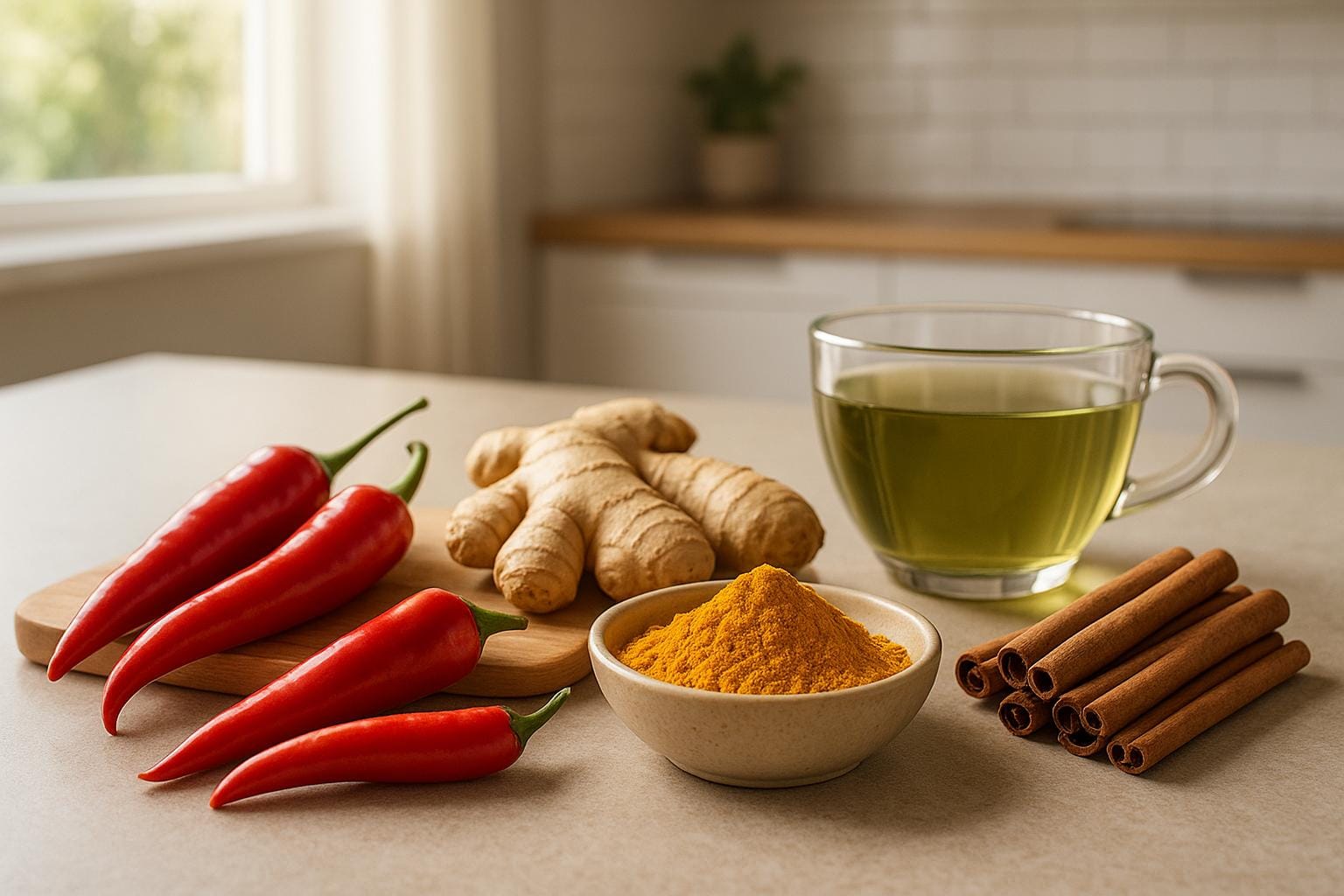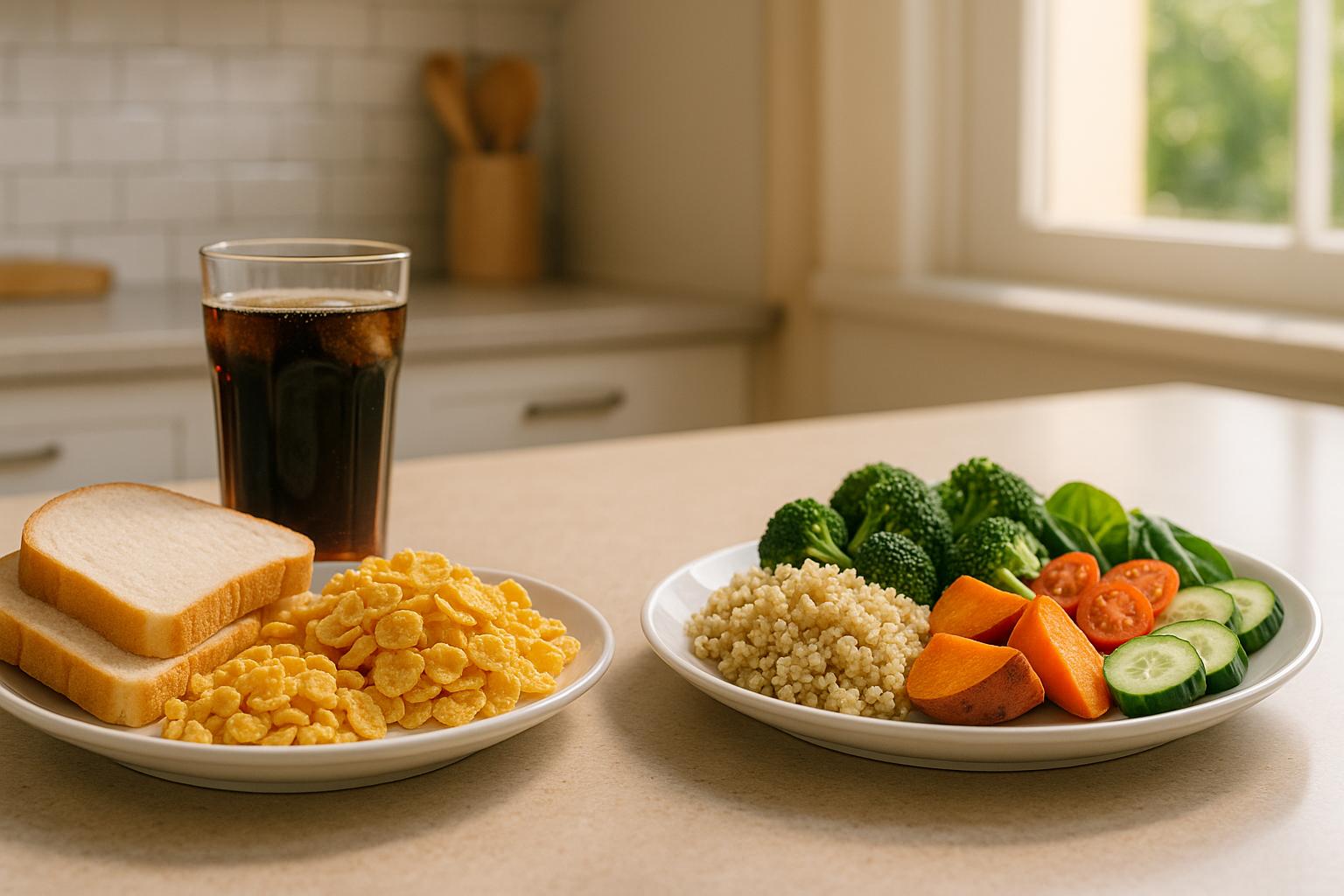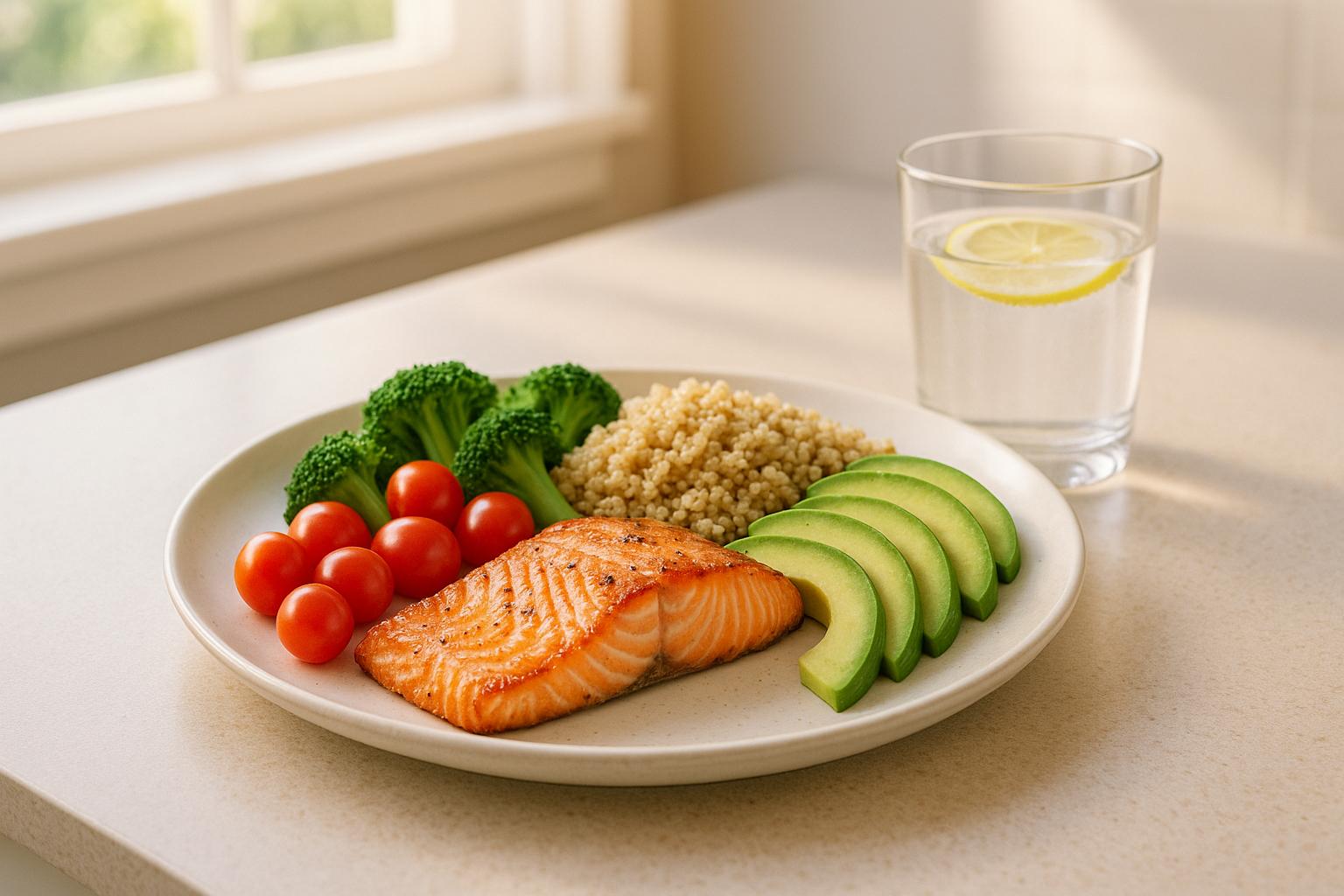Thermogenic foods can help your body burn more calories by boosting metabolism through the process of thermogenesis. These foods require extra energy to digest and process, aiding in fat burning and calorie expenditure. While they aren't a magic solution, incorporating them into a balanced diet with regular exercise can support weight management and overall health.
Key Thermogenic Foods:
- Coffee: Increases resting metabolic rate by 3–11% with caffeine as the primary driver.
- Green Tea: Combines catechins and caffeine to enhance fat oxidation and calorie burn.
- Chili Peppers: Contains capsaicin, which stimulates heat production and fat burning.
- Lean Proteins: High thermic effect, requiring 20–30% of their calories for digestion.
- High-Protein Dairy: Rich in amino acids and calcium, supports fat loss and energy use.
- Whole Grains: Fiber-rich, aiding digestion and increasing calorie burn.
- Ginger: Activates heat production with compounds like gingerols and shogaols.
- Cinnamon: Boosts metabolism through cinnamaldehyde, enhancing fat cell activity.
- Garlic: Stimulates the nervous system and activates calorie-burning processes.
- Fatty Fish: Omega-3 fatty acids improve fat oxidation and thermogenesis.
Quick Tips:
- Start with small changes: Add spices like chili or cinnamon to meals.
- Pair protein with thermogenic foods for maximum calorie burn.
- Drink coffee or green tea in moderation for sustained energy.
- Include fatty fish or lean proteins in meals to support metabolism.
Thermogenic foods are a practical addition to a healthy lifestyle, but they work best when combined with exercise and a well-rounded diet. Consult a healthcare professional before making significant diet changes.
How to Boost Your Metabolism with Thermogenic Foods
How Thermogenic Foods Work
Thermogenesis is your body's way of burning calories to produce heat, which plays a role in your daily energy expenditure.
Your body uses three main types of thermogenesis. Obligatory thermogenesis happens constantly, as your body performs basic metabolic tasks. Facultative thermogenesis kicks in during activities like exercising or even shivering. Lastly, adaptive thermogenesis responds to external factors like cold temperatures, your diet, or certain health conditions.
Thermogenic foods are known to trigger diet-induced thermogenesis (DIT), which can increase energy expenditure by about 10%.
"When you eat foods that boost thermogenesis, your body burns more calories as it works to digest and process the food. This is why some foods can help you burn more calories throughout your day."
– Tiffany Vargas, Fitness Trainer, NASM-CPT
Even though skeletal muscles and brown adipose tissue make up a small portion of your body mass, they significantly contribute to thermogenic activity.
How Nutrients Affect Thermogenesis
Different macronutrients trigger thermogenesis at varying levels:
| Macronutrient | Thermic Effect |
|---|---|
| Protein | 20–30% |
| Carbohydrates | 5–10% |
| Fat | 0–3% |
For instance, digesting protein requires 20–30% of its calorie content, while fats only use 0–3%.
"Protein plays a key role in body weight regulation through satiety related to diet-induced thermogenesis."
– Klaas R Westerterp
Compounds in Thermogenic Foods
Certain compounds in thermogenic foods can activate unique metabolic pathways. For example:
- Capsaicin, found in chili peppers, stimulates heat production and fat burning.
- Catechins in green tea, especially EGCG, promote fat oxidation and thermogenesis.
- Caffeine boosts thermogenesis and heart rate, leading to increased calorie burn.
Interestingly, internal organs are responsible for 56% of thermogenic activity, while the skin, muscles, and brain contribute the rest.
Some thermogenic foods also impact the sympathetic nervous system, which can suppress hunger while increasing calorie burn. This dual effect can help with weight management by making you feel fuller while burning more energy.
How Long Do Thermogenic Effects Last?
The timeline for thermogenic effects varies. Compounds like caffeine work quickly, while others, such as medium-chain triglycerides (MCTs), can boost calorie burn by up to 5% over a 24-hour period.
Even small increases in thermogenesis can make a difference. For instance, one study found that enhanced thermogenesis led to an additional loss of around 0.5 kg of body fat over eight weeks.
Next, we’ll explore practical ways to include thermogenic foods in your daily meals.
This article is for informational purposes only and is not intended as medical advice. Please consult a healthcare professional before starting any new fitness or wellness routine.
1. Coffee
Coffee is one of the easiest thermogenic foods to incorporate into your daily routine, thanks to its ability to boost metabolism and increase calorie burn.
Active Compounds That Support Thermogenesis
Coffee owes its thermogenic properties to several active compounds, including caffeine, theobromine, theophylline, and chlorogenic acid. Caffeine, in particular, plays a key role by blocking adenosine receptors, stimulating the release of important neurotransmitters, and raising cAMP levels in the body. These combined effects promote fat breakdown and enhance thermogenesis. In short, caffeine is the driving force behind coffee's impact on metabolism.
How Coffee Affects Metabolism and Energy Use
Studies show that caffeine can increase resting metabolic rate (RMR) by 3–11%. For example, consuming 100 mg of caffeine can raise RMR by 3–4% over about 2.5 hours, while multiple doses throughout the day can increase daily energy expenditure by 8–11%.
"There have been quite a few studies that suggest higher blood concentrations of caffeine may be associated with a lower body mass index (BMI) and lower body fat mass."
– Allegra Picano, RDN
Caffeine also boosts fat burning, with lean individuals experiencing up to a 29% increase in fat oxidation, compared to about 10% in those with obesity. On top of that, it can enhance exercise performance by an average of 11–12%. Drinking six cups of coffee (around 600 mg of caffeine) over 12 hours can burn roughly 100 extra calories. Research even suggests that for every milligram of caffeine consumed, about one calorie is burned. These findings highlight coffee's role as a powerful thermogenic aid.
Simple Ways to Add Coffee to Your Routine
Adding coffee to your diet is straightforward. Black coffee is the best choice for avoiding extra calories. Drinking it 30 minutes before a workout can enhance both fat burning and performance. For an extra metabolic boost, try adding calorie-free spices like cinnamon or ginger, which also offer additional health benefits. To maintain caffeine's effectiveness, limit your intake to 1–2 cups a day to avoid building a tolerance.
This article is for informational purposes only and is not intended as medical advice. Please consult a healthcare professional before starting any new fitness or wellness routine.
2. Green Tea
Green tea is more than just a soothing beverage - it’s a natural way to give your metabolism a boost. Packed with powerful compounds like catechins and caffeine, green tea works to enhance thermogenesis, which is your body’s ability to burn calories and produce heat. Let’s dive into how it works and why it’s worth adding to your routine.
How Green Tea Fuels Thermogenesis
An 8.5-ounce cup of green tea contains around 50–100 mg of catechins (primarily EGCG) and 30–40 mg of caffeine. EGCG, or epigallocatechin gallate, is the standout catechin, making up as much as 80% of the total catechins in green tea.
Here’s how these compounds work together:
- Catechins (like EGCG): They block the enzyme COMT, which helps preserve norepinephrine, a hormone that promotes fat breakdown.
- Caffeine: It inhibits certain enzymes, allowing cyclic adenosine monophosphate (cAMP) to remain active longer in cells. This extended activity supports fat oxidation.
Together, these two components create a synergistic effect, amplifying your body’s ability to burn fat.
Boosting Metabolism and Burning Calories
Studies show that green tea can lead to a noticeable increase in calorie burning. For instance, a 2020 review found that consuming at least 500 mg of green tea extract daily for 12 weeks resulted in lower body weight and BMI. Regular green tea drinkers also experience an elevated resting metabolic rate and a reduction in visceral fat, which contributes to overall weight loss.
Timing can make a difference too. Drinking green tea before breakfast has been linked to increased energy expenditure throughout the day. Similarly, sipping on Matcha green tea before a workout may help your body burn more fat during exercise.
Easy Ways to Add Green Tea to Your Day
Incorporating green tea into your daily routine is effortless. Whether you enjoy it as a warm morning drink, a matcha latte, or blended into smoothies, it’s a simple way to tap into its metabolism-boosting benefits.
One study from Korea found that women who drank four or more cups of green tea daily had 44% less abdominal fat compared to their male counterparts. While drinking more tea could amplify its effects, even just 1–2 cups a day, paired with a balanced diet and regular exercise, can support your weight management goals.
Green tea is a natural addition to a healthy lifestyle, but always consult a healthcare professional before making significant changes to your diet or fitness routine.
3. Chili Peppers
Chili peppers are a fiery way to rev up your metabolism. They work by increasing your body’s heat production, essentially turning up the internal thermostat, which can help with calorie burning.
How Chili Peppers Trigger Thermogenesis
The magic behind chili peppers lies in capsaicin, the active compound responsible for their heat. Capsaicin makes up about 70% of the heat-inducing properties in these peppers and activates TRPV1 receptors in your body. This activation sparks thermogenesis, which not only burns calories but also boosts your cellular energy output.
Interestingly, a milder cousin of capsaicin, called capsiate, also activates these receptors without the intense burning sensation. Both compounds are equally effective at triggering this calorie-burning process.
Metabolic Benefits You Can Feel
The effects of chili peppers on your metabolism kick in almost immediately. By activating TRPV1 receptors, they encourage your body to burn calories at a faster rate - even after you’ve finished eating. This makes them an excellent choice for anyone looking to support energy expenditure through diet.
Easy Ways to Add Chili Peppers to Your Diet
Beyond their metabolism-boosting perks, chili peppers are incredibly versatile in the kitchen. You can enjoy them raw, roasted, grilled, pan-seared, or even stuffed . For milder heat, try removing the seeds and ribs, or soak the peppers in salted water to tone down their spiciness . Sautéing them in oil is another great way to incorporate their flavor into your meals.
Here are some simple ideas to spice up your meals:
- Sprinkle crushed red pepper flakes on pizza or pasta.
- Add habaneros to fajitas, salsas, or marinades.
- Use serranos in chili stews, guacamole, or seafood dishes.
- Experiment with dried chiles by infusing them into oils or making chili pastes for sauces and stews .
Chili peppers are also a staple in spice blends like chili powder, curry powder, and cayenne. Whether you’re a spice lover or just starting to explore heat in your cooking, you can easily adjust their intensity to suit your taste.
As with any spicy food, start small and work your way up to avoid overwhelming your palate. And remember, handle hot peppers carefully to avoid irritation.
This article is for informational purposes only and is not intended as medical advice. Always consult a healthcare professional before making changes to your diet or wellness routine.
4. Lean Proteins
Lean proteins are a standout choice among thermogenic foods because they require more energy to digest while also helping to preserve muscle mass. When you consume protein, your body burns 20–30% of its calories during digestion, which is far higher compared to carbs (5–10%) and fats (0–3%). This higher energy demand not only helps burn more calories but also supports muscle maintenance, which is key to increasing daily energy expenditure.
Impact on Metabolism and Energy Expenditure
"There is convincing evidence that a higher protein intake increases thermogenesis and satiety compared to diets of lower protein content." - PubMed
Research highlights the benefits of increasing protein intake to 30% of your daily calories. Doing so can naturally reduce overall calorie consumption by around 441 calories per day and lead to an average weight loss of 11 pounds over 12 weeks. High-protein diets have also been shown to boost daily calorie burn by 80–100 calories, with some studies reporting increases as high as 260 calories per day during overfeeding. What’s more, this metabolic boost doesn’t stop when you’re asleep - it continues around the clock.
Lean proteins also play a crucial role in preserving fat-free mass, which includes metabolically active tissues like muscle that burn calories even at rest. Maintaining this muscle mass is vital for keeping your baseline metabolic rate higher.
Ease of Incorporation into Meals
To maximize the benefits of lean proteins, aim to distribute your intake evenly across meals. A good rule of thumb is 0.7–1 gram of protein per pound of lean body mass, or roughly 30–40 grams per meal. Incorporating a mix of lean animal-based and plant-based proteins not only helps with calorie management but also supports heart health by reducing saturated fat intake. Excellent protein options include chicken breast, turkey, lean beef, pork tenderloin, fish, eggs, Greek yogurt, and legumes.
When preparing lean proteins, focus on cooking methods that don’t add unnecessary calories. Trim visible fat from meats and remove poultry skin. Opt for low-fat cooking techniques like broiling, roasting, grilling, baking, or sautéing. As UnityPoint Health notes:
"Your body burns slightly more calories digesting protein than fat and carbohydrates." - UnityPoint Health
In addition to their metabolic benefits, lean proteins help you feel fuller longer compared to other macronutrients. This often leads to a natural reduction in overall calorie intake. The efficient digestion of protein and its role in supporting muscle mass make it a cornerstone of a healthy metabolism and energy balance.
This article is for informational purposes only and is not intended as medical advice. Please consult a healthcare professional before starting any new fitness or wellness routine.
5. High-Protein Dairy
High-protein dairy isn't just a great addition to your meals - it actively supports energy expenditure and fat loss. Thanks to its unique combination of nutrients, it boosts metabolism and promotes fat-burning. Unlike calcium supplements, dairy provides not only calcium but also bioactive compounds that amplify its metabolic effects. Let's dive into the details of these active compounds and their benefits.
Active Compounds That Boost Thermogenesis
The thermogenic power of high-protein dairy comes from its rich supply of branched-chain amino acids (BCAAs). In particular, whey protein contains a high concentration of leucine (about 26%), which helps redirect dietary energy away from fat storage and toward muscle building. Dairy also contains natural angiotensin-converting enzyme (ACE) inhibitors, which play a role in regulating fat storage. When combined with calcium, these bioactive compounds create a more potent metabolic response than calcium supplements alone.
Impact on Metabolism and Energy Expenditure
Studies have shown that calcium from dairy sources is more effective at reducing weight and fat gain compared to calcium supplements. For instance, increasing dietary calcium intake - going from about 400 mg to 1,000 mg daily by consuming two cups of yogurt - can lead to a reduction in body fat of approximately 10.8 pounds. High-calcium dairy also decreases fat production (lipogenesis) by 51% and enhances fat breakdown (lipolysis) by 3–5 times, resulting in a 26–39% decrease in body weight and fat accumulation.
Dairy protein, which is made up of 80% casein and 20% whey, further enhances energy expenditure. Whey protein, in particular, is quickly absorbed and has an amino acid profile that supports thermogenesis. Higher dairy consumption has been associated with a 72% lower risk of insulin resistance, and including three servings of dairy daily has been shown to reduce total body fat by 5.4% and trunk fat by 4.6% in obese adults.
Easy Ways to Add High-Protein Dairy to Your Diet
Incorporating high-protein dairy into your meals doesn’t have to be complicated. Here are a few simple ideas:
- Greek yogurt: A 6-ounce serving provides an impressive 16.6 grams of protein.
- Cottage cheese: A half-cup delivers about 12 grams of protein.
- Low-fat kefir: Offers 9 grams of protein per cup.
- Milk: Contains 8 grams of protein per cup.
Start your day with Greek yogurt topped with berries and seeds, or blend a smoothie with low-fat milk, Greek yogurt, and fruit. Greek yogurt can also replace higher-calorie ingredients like sour cream or mayonnaise in dips, dressings, and sauces. Cottage cheese works wonderfully in egg flatbreads paired with turkey and avocado, as a chili crisp dip ingredient, or spread on toast with salmon, cucumber, and dill. Kefir can be used in recipes like apple cinnamon baked oatmeal cups or berry acai bowls.
If you’re lactose intolerant, there are plenty of options for you, too - lactose-free versions of yogurt, Greek yogurt, cottage cheese, milk, and cheese are widely available. Consistency is key, so aim to include 2–3 servings of high-protein dairy throughout your day to fully tap into its thermogenic benefits.
This article is for informational purposes only and is not intended as medical advice. Please consult a healthcare professional before starting any new fitness or wellness routine.
6. Whole Grains
Whole grains may not pack the same thermogenic punch as protein, but they’re still a great way to rev up your metabolism. Unlike refined grains, which lose their outer layers during processing, whole grains keep all their parts intact - the endosperm, germ, and bran. This means they’re loaded with fiber, polyphenols, and essential minerals that not only help with weight management but also keep your metabolism humming. Plus, their nutrient profile helps you feel fuller for longer, making them a smart choice for anyone looking to stay satisfied and energized.
How Whole Grains Support Thermogenesis
The secret weapon of whole grains is their fiber content. While they don’t provide the same dramatic metabolic boost as protein (which can increase energy expenditure by 15-30%), whole grains still require energy to digest and process. That means your body burns calories just by breaking them down.
Soluble fiber in whole grains plays a key role here. It triggers gut hormones that slow digestion, helping you feel full longer. Even better, it ferments into short-chain fatty acids (SCFAs) in your gut, which can influence appetite and energy use.
Whole Grains and Energy Burn
Here’s the kicker: studies suggest that swapping refined grains for whole grains can lead to an extra 100 calories burned per day. That’s about the same as taking a brisk 30-minute walk! How? Whole grains help you lose calories by reducing the amount your body retains during digestion and by speeding up your metabolism.
"This study helps to quantify how whole grains and fiber work to benefit weight management, and lend credibility to previously reported associations between increased whole grains and fiber consumption, lower body weight and better health" - Phil J. Karl, PhD, Nutrition Scientist at the U.S. Army Research Institute of Environmental Medicine
But that’s not all. Whole grains also reduce hunger more effectively than refined grains. A meta-analysis found that people who ate whole grains reported feeling less hungry compared to those who ate refined grains. Over time, this can make a big difference in managing weight and reducing the risk of obesity.
Unfortunately, many Americans don’t get enough fiber - most consume far less than the recommended daily intake of 15 grams. The 2015-2020 Dietary Guidelines for Americans emphasize replacing refined grains with whole grains, suggesting at least three ounces daily for women and four ounces for men.
Easy Ways to Add Whole Grains to Your Diet
The good news? Adding more whole grains to your meals doesn’t have to be complicated. A few simple swaps can go a long way in boosting your intake and reaping the metabolic benefits.
- For breakfast: Try whole grain hot cereals like oatmeal, buckwheat, or millet. Or go for 100% whole wheat bagels and English muffins.
- For lunch and dinner: Use whole grain bread for sandwiches. Serve brown rice, quinoa, barley, or farro as side dishes. Mix things up with multigrain bowls topped with veggies, lean proteins, and low-fat cheese.
- For snacks: Reach for 100% whole grain crackers or tortilla chips. Make mini pizzas with whole-wheat English muffins or tortillas as the base.
The key is consistency - aim for at least three servings of whole grains each day. Whether you’re trying out new options like quinoa or sticking with classics like brown rice and oatmeal, these nutrient-packed foods can help keep your metabolism on track while keeping you full and satisfied.
This article is for informational purposes only and is not intended as medical advice. Please consult a healthcare professional before starting any new fitness or wellness routine.
7. Ginger
Ginger, much like chili peppers and green tea, contains compounds that naturally support thermogenesis. This warming spice is packed with bioactive components that can positively impact your metabolism. The key players here are gingerols and shogaols, which work similarly to capsaicin by activating heat-producing processes in the body.
How Ginger Fuels Thermogenesis
The thermogenic properties of ginger come from its active compounds - gingerols and shogaols. These compounds, particularly their vanillyl moiety, stimulate TRPV1 receptors, triggering the sympathetic nervous system and releasing adrenaline. This cascade of activity ramps up heat production in the body.
Fresh ginger is rich in gingerols, but when dried, these convert into shogaols, which further amplify its thermogenic effects.
Boosting Metabolism and Energy Output
Research shows that ginger can significantly increase calorie burn. For instance, drinking ginger powder dissolved in hot water can raise the thermic effect of food by 43 calories, while ginger tea may boost daily energy expenditure by around 95.5 to 113 calories. Beyond calorie burning, ginger also helps manage appetite by promoting satiety and reducing hunger.
Consuming just 1 to 2 grams of ginger daily has been linked to weight loss benefits, including reductions in body weight. These findings make ginger a simple yet effective addition to meals and beverages.
Easy Ways to Add Ginger to Your Diet
Incorporating ginger into your daily routine is surprisingly easy. A popular option is ginger tea - just steep fresh slices in hot water for a soothing start to your day. Fresh ginger is also a fantastic addition to stir-fries, curries, and soups. For the best flavor, add it early in the cooking process to let its warmth infuse the dish. You can also sprinkle ginger powder on roasted veggies or mix it into oatmeal or yogurt for a cozy breakfast.
For those who prefer drinks, smoothies and fresh juices are excellent options. Grating a small amount of ginger into your blend adds a spicy kick. Another idea? Infuse your water with ginger slices for a refreshing twist throughout the day.
"Ginger can help with weight loss by increasing your metabolism and boosting digestion, making it easier to burn calories throughout the day." - Orion Health & Wellness Services
For a creative spin, try experimenting with ginger-infused syrups or spreads to elevate your meals and snacks.
This article is for informational purposes only and is not intended as medical advice. Please consult a healthcare professional before starting any new fitness or wellness routine.
8. Cinnamon
This warm and aromatic spice does more than just enhance flavors - it can also give your metabolism a boost. Like other thermogenic foods, cinnamon helps convert food into heat, ramping up your body’s energy expenditure. Studies have shown that cinnamon contains unique compounds that play a role in thermogenesis, the process where your body burns calories to produce heat.
Compounds That Support Thermogenesis
Cinnamon owes its thermogenic properties to key compounds such as cinnamaldehyde, eugenol, and coumarin. Among these, cinnamaldehyde stands out - it activates fat cells to burn energy and stimulates protein kinase A (PKA), which further enhances fat cell metabolism. If you're incorporating cinnamon into your diet, opt for Ceylon cinnamon to limit your intake of coumarin.
How It Impacts Metabolism and Energy Use
Cinnamon’s benefits extend beyond its enticing aroma. A 2024 study in the Journal of Nutritional Science highlighted how cinnamaldehyde can trigger thermogenesis and significantly enhance fat metabolism. When exposed to cinnamaldehyde, human fat cells show increased activity in metabolism-boosting genes and enzymes, encouraging greater fat burning.
In a controlled study with 116 participants who had metabolic syndrome, consuming 3 grams of cinnamon daily led to a dramatic reduction in the prevalence of the condition - 34.5% in the cinnamon group compared to just 5.2% in the placebo group. Beyond metabolism, cinnamon also helps regulate blood sugar levels and reduce cravings, making it a well-rounded addition to your diet.
Dr. Jun Wu from the University of Michigan Medical School, an expert on cinnamon’s effects, explains:
"Cinnamon has been part of our diets for thousands of years, and people generally enjoy it. So if it can help protect against obesity, too, it may offer an approach to metabolic health that is easier for patients to adhere to."
Easy Ways to Add Cinnamon to Your Diet
Adding cinnamon to your meals is incredibly simple. This versatile spice pairs well with both sweet and savory dishes. Stir a teaspoon into your morning coffee, smoothie, or oatmeal. Sprinkle it over fresh fruit like apples or bananas for a quick snack. For breakfast, try adding it to porridge, dusting it over toast with peanut butter and banana, or mixing it into pancake batter.
Cinnamon isn’t just for sweet treats - it works wonders in savory dishes too. Use it in spice rubs for chicken, pork, or fish, or toss a cinnamon stick into rice as it cooks. It’s also a great addition to stews, curries, and roasted vegetables like sweet potatoes, butternut squash, and carrots. Even beverages can benefit - try a cinnamon and ginger latte or add a pinch to chai tea.
The key is consistency. Incorporating small amounts of cinnamon throughout your day can help maintain its thermogenic benefits while adding a flavorful twist to your meals. Its versatility makes it an easy and delicious way to support your metabolism and complement other thermogenic foods.
This article is for informational purposes only and is not intended as medical advice. Please consult a healthcare professional before starting any new fitness or wellness routine.
9. Garlic
Garlic is a powerhouse ingredient that can help speed up your metabolism thanks to its thermogenic properties. Packed with sulfur compounds, garlic stimulates your body to produce more heat and expend energy, making it a natural ally in boosting metabolic activity. Whether you prefer it roasted with veggies or raw in the morning, garlic is an easy and flavorful way to support your energy-burning goals.
How Garlic Fuels Thermogenesis
The secret to garlic's thermogenic magic lies in its active compounds, particularly alliin and volatile sulfur compounds. When you crush garlic, alliin converts into allicin, a compound known for its metabolism-boosting abilities. These compounds have been shown to increase norepinephrine secretion, which activates the sympathetic nervous system and ramps up energy expenditure. Additionally, diallyldisulfide, another sulfur compound in garlic, enhances norepinephrine activity through β-adrenergic pathways.
Metabolic Benefits of Garlic
Research highlights garlic's ability to activate brown adipose tissue, a type of fat that burns calories to produce heat. It also increases oxygen consumption, signaling a faster metabolism and improved fat oxidation. In cold exposure studies, garlic-treated mice maintained higher body temperatures during a six-hour test at around 39°F, demonstrating its potential to support thermogenesis. Furthermore, garlic helps regulate metabolism by activating AMP-activated protein kinase (AMPK), an enzyme that promotes fat burning and energy production across various tissues. Together, these effects make garlic a valuable addition to diets aimed at reducing fat storage and boosting calorie burn.
Simple Ways to Add Garlic to Your Diet
Incorporating garlic into your daily routine is incredibly straightforward. For maximum metabolic benefits, try consuming raw garlic on an empty stomach in the morning. Crush 1–2 cloves and mix them with warm water for a quick boost. If the taste is too strong, you can mix the crushed garlic with a teaspoon of honey or combine it with lemon juice and warm water for a milder option. Another idea is garlic tea - boil crushed cloves in water and add cinnamon, honey, and lemon for a soothing drink.
For everyday meals, garlic adds both flavor and thermogenic benefits. Minced or crushed garlic can elevate soups, sauces, stir-fries, and roasted vegetables. To preserve its active compounds, add raw garlic to dishes right before serving, as prolonged heat can reduce its effectiveness. Garlic-infused oil is another versatile option, perfect for drizzling over salads or roasted veggies. For example, you could roast salmon with minced garlic, olive oil, lemon juice, and seasonings or whip up a hearty soup with kale, garlic, and onions. Even a simple shrimp stir-fry with garlic and mixed vegetables can pack a metabolic punch while tasting great.
The key to reaping garlic’s benefits is consistency. Regularly including it in your meals not only supports your metabolism but also enhances the flavor of your cooking. It’s a small, flavorful step toward a more thermogenic diet.
10. Fatty Fish
Fatty fish is an excellent addition to your diet if you're looking to support your metabolism. Packed with omega-3 fatty acids - specifically EPA (eicosapentaenoic acid) and DHA (docosahexaenoic acid) - these fish not only provide high-quality protein but also contain fats that can help with weight management by boosting thermogenesis.
How Fatty Fish Supports Thermogenesis
The thermogenic effects of fatty fish primarily stem from their omega-3 fatty acids. These essential nutrients can stimulate thermogenic processes in your body, raising your core temperature and increasing energy expenditure. Salmon, herring, mackerel, and sardines are standout options, delivering between 1,000 and 2,600 mg of EPA and DHA per 100 grams.
Metabolic Benefits of Omega-3s
Omega-3 fatty acids in fatty fish play a direct role in enhancing your metabolism. Regularly eating these fish has been linked to several metabolic advantages. For example, a 2015 study revealed that fish oil supplementation could increase resting metabolic rate by 14%, boost energy expenditure during exercise by 10%, and improve fat oxidation both at rest and during physical activity. Beyond calorie burning, fatty fish may also help regulate key metabolic hormones like insulin and leptin, which influence appetite and fat storage. Additionally, the protein found in fish adds to its thermogenic properties, as digesting protein requires more energy.
For overall metabolic health, the American Heart Association suggests adults aim for about 500 mg of EPA and DHA daily, which is roughly equivalent to two servings (around 8 ounces) of fish per week.
Simple Ways to Add Fatty Fish to Your Diet
Whether fresh or canned, fatty fish is a convenient and affordable way to increase your omega-3 intake. Start with breakfast by mixing sardines into scrambled eggs or topping avocado toast with smoked salmon.
Lunch is another great opportunity to include fatty fish. Try canned tuna, salmon, sardines, or mackerel in power bowls, sandwiches, soups, or pasta dishes . You can even get creative with recipes like salmon meatballs served with cucumber yogurt or a classic tuna Niçoise salad.
For dinner, swap out traditional proteins for fatty fish. Replace chicken breast with salmon fillets or use ground sockeye salmon instead of beef for a nutrient-packed alternative. You can also prepare white fish with lemon, olive oil, fresh herbs, and capers for a simple yet flavorful meal.
"Wild-caught seafood provides essential protein, Omega-3s, DHA, and vitamin D, anchoring a healthy diet." – Wild Alaskan Company
To make the most of its thermogenic benefits, aim to eat two 3-ounce servings of fatty fish each week. Whether you choose fresh, frozen, or canned options, incorporating fatty fish into your meals is an easy way to boost your metabolism and help your body burn more calories throughout the day.
This article is for informational purposes only and is not intended as medical advice. Please consult a healthcare professional before starting any new fitness or wellness routine.
How to Add Thermogenic Foods to Your Diet
Adding thermogenic foods to your meals doesn’t have to be complicated. With a few smart swaps and some thoughtful planning, you can easily include these metabolism-friendly options in your daily diet without overhauling your routine. Here’s how you can integrate them into breakfast, lunch, dinner, and even snacks.
Start Your Day with Protein and Spice
A protein-packed breakfast can set the tone for your metabolism for the rest of the day. Research indicates that starting your morning with a protein-rich meal may help reduce overall calorie intake. Consider scrambled eggs with black beans and peppers for a hearty start.
Want to kick it up a notch? Add chili peppers or a pinch of cayenne to your eggs for an extra metabolic boost. Pair your breakfast with coffee or green tea. Stick to two to three 12-ounce cups of coffee daily (staying under 400 mg of caffeine) or up to 4 cups of green tea spaced throughout the day. For an added antioxidant punch, squeeze some lemon into your green tea.
For a fiber-rich option, try oatmeal topped with walnuts. Sprinkle up to 6 grams of cinnamon into your oatmeal, tea, or yogurt to enhance its thermogenic properties.
Power Up Your Midday Meals
Lunch is another great opportunity to incorporate thermogenic foods. A broth-based vegetable soup with chickpeas or black beans is a simple way to add protein and fiber. Pairing protein or healthy fats with high-fiber carbohydrates not only keeps you full but also stabilizes blood sugar levels.
Looking for variety? Try a taco bowl with sweet potatoes, black beans, and avocado lime dressing. The sweet potatoes provide complex carbs, while the beans deliver protein, making this a satisfying and thermogenic meal. Another option is a tuna salad with cranberries, served on whole-grain bread, crackers, or lettuce cups.
Maximize Your Evening Metabolism
Dinner is the perfect time to combine multiple thermogenic ingredients. Spice up chicken breasts with a cayenne pepper rub or serve fatty fish like salmon alongside a baked sweet potato for a balanced meal. The mix of lean protein, healthy fats, and spices works wonders for your metabolism.
Stir-fries are another easy way to incorporate thermogenic foods. Combine a protein source (like chicken, steak, shrimp, or tofu) with non-starchy vegetables and a carb like rice or noodles. For added flavor and metabolic benefits, include 1 minced garlic clove and fresh ginger.
Strategic Food Combinations
Combining thermogenic foods thoughtfully can amplify their effects. Protein, for example, has the highest thermic effect of all macronutrients, increasing energy expenditure by 20-30%, compared to just 0-3% for fats and 5-10% for carbs. Aim for 30-40 grams of protein per meal to maximize fat-burning potential.
"High-thermic foods are helpful in facilitating sustainable weight loss and/or weight management due to their highly satiating effect and high protein content, which helps maintain lean body mass while losing weight." - Victoria Whittington, RDN
One study found that protein-rich meals not only boosted the thermic effect but also increased feelings of fullness compared to meals high in carbs or fats, even when calorie counts were the same. This highlights the importance of strategic food pairing.
Portion Control and Timing
To get the most out of thermogenic foods without overdoing it, portion control is key. For example, limit coconut oil to 2 tablespoons per day, which you can mix into smoothies, salad dressings, or fruit salads. Similarly, keep cocoa powder to 2 tablespoons daily, adding it to yogurt, milk, or fruit, or opt for dark chocolate with at least 70% cocoa content.
Snacking Strategy
Snacks are a great opportunity to sneak in thermogenic foods. Try Greek yogurt topped with cinnamon and berries, or enjoy a small handful of nuts paired with green tea. These combinations not only support your metabolism but also help maintain steady energy levels throughout the day.
Start small by adding one or two thermogenic foods to each meal, and gradually build from there. Keep in mind that factors like age, activity level, and body composition can influence how these foods affect your metabolism.
This article is for informational purposes only and is not intended as medical advice. Always consult a healthcare professional before making changes to your diet or wellness routine.
Conclusion
Thermogenic foods offer a natural way to give your metabolism a boost, helping your body burn more energy throughout the day. By adding options like coffee, green tea, chili peppers, lean proteins, and nutrient-packed spices to your meals, you can support your body’s fat-burning processes while also enjoying their flavorful benefits.
The science backs this up: protein can increase your metabolism by 15–30%, and caffeine has been shown to enhance calorie burning over time. These findings highlight the potential of thermogenic foods as a practical addition to your diet.
Beyond metabolism, these foods can also sharpen focus and improve workout performance. They work by promoting thermogenesis, making them a great complement to your overall wellness efforts.
That said, thermogenic foods are most effective when paired with regular exercise and a balanced diet. Start small - try incorporating one or two of these foods into your daily routine - and build from there. With consistency, they can become a valuable part of your long-term health plan.
Before making major changes to your diet, it’s wise to consult a healthcare professional, especially if you have health conditions or are on medication. Personalized advice ensures these strategies work best for your needs.
This article is for educational purposes only and should not replace professional medical advice. Always consult a healthcare provider before starting any new health or fitness routine.
FAQs
How do thermogenic foods help with weight loss and boosting metabolism?
Thermogenic foods play a role in weight loss by increasing your body's energy use through a process called thermogenesis - essentially, they help you burn extra calories. Options like chili peppers, green tea, coffee, and protein-packed foods activate your nervous system, which promotes fat breakdown and gives your metabolism a boost.
By naturally ramping up calorie burning, these foods can help you achieve and maintain a calorie deficit, which is crucial for losing fat. Adding them to your diet not only supports weight management but also offers other health perks.
Can eating too many thermogenic foods harm your health?
While thermogenic foods can give your metabolism a little push, overdoing it might backfire on your health. Foods loaded with stimulants like caffeine can bring about side effects such as a racing heart, elevated blood pressure, trouble sleeping, nausea, and feeling jittery or restless. Going overboard with thermogenic supplements could lead to even more serious problems like dehydration, liver strain, or even heart-related issues.
To keep things safe, enjoy these foods in moderation. If you’re unsure how they might impact your health, it’s always a good idea to check in with a healthcare professional.
Can combining certain thermogenic foods make them more effective at boosting metabolism?
Yes, combining certain thermogenic foods can increase their calorie-burning effects. For instance, pairing chili peppers with green tea or ginger can create a powerful combination, boosting their natural metabolism-enhancing properties. In simple terms, your body might burn more calories when these foods are eaten together rather than individually.
To work these combinations into your diet, consider sprinkling cayenne pepper into a green tea-based soup or mixing fresh ginger into a coffee smoothie. These easy tweaks not only help you get the most out of thermogenic foods but also keep your meals tasty and enjoyable.












